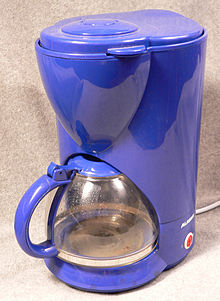Electrical appliance

An electrical device is a device that uses, generates or measures electrical energy for its operation.
Electrical devices are connected directly to the power grid ( e.g. kettle , dishwasher , lamp ), equipped with accumulators or batteries (e.g. mobile phone , flashlight ) or they generate electrical energy themselves (portable power generator , plug-in photovoltaic module ). Movable measuring and testing devices (e.g. multimeters , phase testers ) for electrical current are also electrical devices.
Electrical consumers are electrical devices as long as they can be moved.
Definition of terms
Electrical appliances for private households in the narrower sense are electrical household appliances that must be distinguished from appliances or machines that are mainly used for commercial purposes . However, it is difficult to draw a clear line, at least for some product groups, for example do-it-yourself equipment. Even privately used devices for outdoor use (see garden tools ) are not considered household devices .
Devices for private households
In the case of electrical appliances for private use , especially in the area of kitchen appliances , a distinction is made between large electrical appliances (e.g. refrigerator ) and small electrical appliances (e.g. hairdryer ).
There is also a division into
- White goods (especially kitchen appliances),
- Brown goods ( consumer electronics ),
- Red goods ( heaters ) and
- Gray goods ( information and communication electronics ).
This is now out of date in colloquial language , but can still be found frequently in the lingua franca of industry , ( retail ) trade and waste management, and occasionally in statistics . In Austria, the terms white goods , brown goods , red goods and gray goods are more common. - The expressions derived in particular from the original body color of the devices from: white enamel with large household appliances, brown wooden frame at (eg washing machines.) Radio appliances, heating helixes give red radiation from, and in the ICT the housing (were such. B. Computer case ) predominantly gray.
Technical details
According to the district of Friesland, electrical devices are devices that require electrical currents or electromagnetic fields for their operation, and devices for generating, transmitting and measuring such currents and fields and designed for operation with alternating current of no more than 1,000 volts or direct current of no more than 1,500 volts are.
These are all independently operable electrical assemblies, from night lights to freezers . The electrical law regulates which electrical devices must be registered when they are placed on the market, their disposal quota and the participation of those who put them on the market in disposal. The background to this is the steadily increasing amount of electronic waste and the associated dangers (hazardous substances) and opportunities (recycling of the valuable substances it contains) in disposal.
The minimum requirements for the safety of electrical devices (fire protection, protection against touching live parts, risk of burns, risk of injury from moving parts) are regulated by law.
See also
Individual evidence
- ↑ https://www.duden.de/rechtschreibung/Elektrogeraet Dudeneintrag
- ↑ Device In: Digital dictionary of the German language of the 20th century. Berlin-Brandenburg Academy of Sciences and Humanities (ed.), 2003.
- ^ Information from the district of Friesland